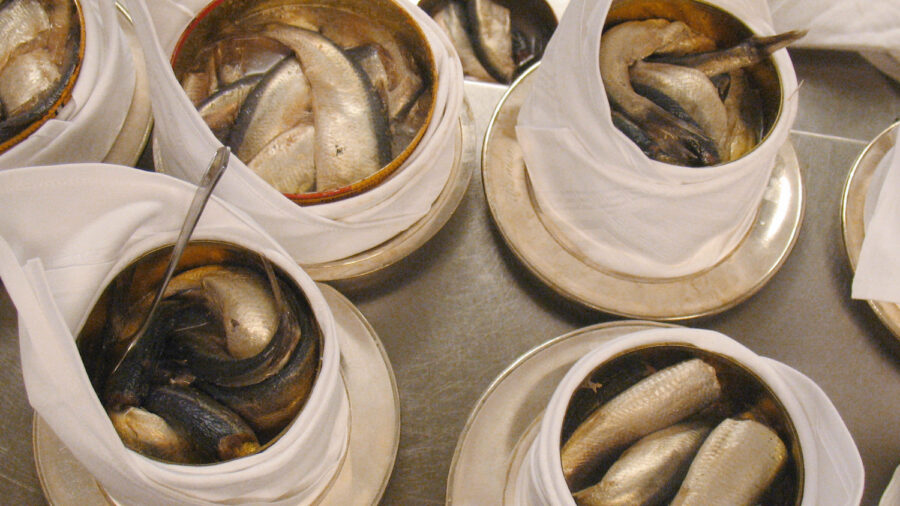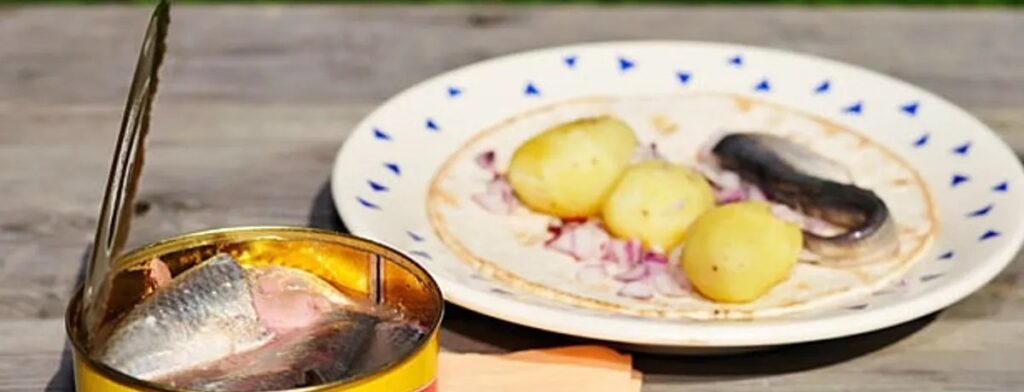Swedish fermented fish, also known as surströmming, is a unique delicacy that has been enjoyed by Swedes for centuries.

What is Swedish Fermented Fish?
It is made from herring that has been caught in the Baltic Sea and then fermented using salt and water.
The fermentation process creates a distinct sour taste and pungent smell that can be off-putting to some but is beloved by many.
Surströmming is typically consumed during late summer and early fall when the herring is at its peak flavour.
It is often served with crispbread, potatoes, onions, and sour cream.
While it may not be for everyone, those who enjoy surströmming consider it to be a true taste of Sweden.
The History and Origins of Swedish Fermented Fish: How it Became a National Treasure
The history of surströmming dates back to the 16th century, when fishermen in northern Sweden began preserving their catch using salt.
Over time, they discovered that allowing the fish to ferment before eating them improved their flavour and texture.
Surströmming’s Popularity in Sweden
By the 19th century, surströmming had become a popular food throughout Sweden.
Today, it is considered a national treasure and is celebrated each year with a festival in the town of Skeppsmalen.
Surströmming’s Importance in Swedish Culture
While surströmming may have humble origins, it has become an important part of Swedish culture and cuisine.
Surströmming is not just a food, it’s a cultural experience.
It’s a way for Swedes to connect with their heritage and traditions.
Surströmming is typically eaten with potatoes, onions, and sour cream.
It is often served on crispbread or tunnbröd, a type of Swedish flatbread.
Controversy Surrounding Surströmming
Despite its popularity in Sweden, surströmming is not without controversy.
Its strong smell has led to it being banned on some airlines and public transportation systems.
Surströmming is definitely an acquired taste.
Some people love it, while others can’t stand the smell.
Despite this, surströmming remains a beloved part of Swedish cuisine and culture.
How is Swedish Fermented Fish Made?

To make surströmming, fresh herring is first cleaned and gutted.
It is then layered with salt in large barrels and left to ferment for several months.
During this time, lactic acid bacteria break down the proteins and fats in the fish, creating a sour taste and strong aroma.
The Fermentation Process
The fermentation process is crucial to the creation of surströmming.
The fish must be left to ferment for several months, allowing the lactic acid bacteria to break down the proteins and fats in the fish.
This process creates the sour taste and strong aroma that surströmming is known for.
It is important to note that the fermentation process must be done properly to ensure the safety of the fish.
Improper fermentation can lead to food poisoning, so surströmming should only be consumed from a reputable source.
Canning and Selling
Once the fermentation process is complete, the fish are canned and sold.
The cans are airtight and often bulge due to the continued fermentation process.
This is a sign that the surströmming is fresh and ready to eat.
Surströmming should only be consumed from a reputable source, as improper fermentation can lead to food poisoning.
Surströmming is a traditional Swedish dish that is often served with potatoes, onions, and sour cream.
It is typically eaten outdoors due to its strong aroma, which can be overwhelming in enclosed spaces.
Consumption
When consuming surströmming, it is important to open the can outdoors or under water.
This is because the fermentation process creates gas that can cause the can to burst open and spray the surrounding area with a strong odour.
The cans are airtight and often bulge due to the continued fermentation process.
This is a sign that the surströmming is fresh and ready to eat.
Despite its strong aroma, surströmming is a beloved dish in Sweden and is often enjoyed at parties and gatherings.
It is a unique culinary experience that is not to be missed by adventurous eaters.
Rakfisk, Gravlax, and Other Swedish Fermented Fish: A Comprehensive Guide to the Various Types
Sweden is known for its love of fermented fish, with surströmming being the most well-known variety.
However, there are many other types of fermented fish to explore.
Here are some of the most popular:
Rakfisk
Rakfisk is a Norwegian dish that involves fermenting trout or char in salt for several months.
The result is a strong-flavoured fish that is often served with flatbread and sour cream.
Gravlax
Gravlax, also known as cured salmon, is made by rubbing fresh salmon with a mixture of salt, sugar, and dill before letting it cure for several days.
The result is a flavorful and tender fish that is often served on rye bread with mustard sauce.
Soused Herring
Soused herring is made by marinating herring in vinegar, sugar, and spices.
It is typically served cold with onions and potatoes.
Soused herring is a popular dish in Sweden, often served at traditional celebrations such as Midsummer.
Lutefisk
Lutefisk is a traditional Scandinavian dish that involves soaking dried cod in lye before cooking it.
While not technically fermented, it has a gelatinous texture and mild flavour.
Lutefisk is a divisive dish, with some people loving its unique texture and flavour, while others find it unappetizing.
These are just a few examples of the many types of fermented fish that can be found in Sweden and Norway.
Each has its own unique flavour and texture, making them worth trying for anyone interested in Scandinavian cuisine.
The Proper Way to Open and Serve Surströmming: Avoiding the Infamous Smell

Surströmming is a Swedish delicacy that is notorious for its pungent smell.
To avoid offending your senses (and those around you), it’s important to open and serve the fish correctly.
Opening the Can
First, make sure to open the can outdoors or in a well-ventilated area.
The pressure inside the can may cause liquid to spray out, so be prepared with towels or a bucket to catch any spills.
It’s also important to use a special surströmming opener, which is designed to puncture the can without damaging the fish inside.
Opening a surströmming can be a messy process, so it’s important to take precautions to avoid any spills or accidents.
Once the can is open, carefully remove the lid and place it to the side.
You may notice a strong smell at this point, but don’t worry – it will dissipate once the fish is removed from the can.
Preparing the Fish
Next, remove the fish from the can and rinse it thoroughly with water.
Some people choose to soak the fish in milk or beer before serving to further reduce the smell.
This step is important to remove any excess brine and to ensure that the fish is clean and ready to eat.
Rinsing the fish is a crucial step in preparing surströmming, as it helps to remove any excess brine and reduce the smell.
Once the fish is rinsed, it’s time to prepare it for serving.
Use a sharp knife to carefully remove the skin and bones, leaving only the tender flesh.
Some people prefer to eat the whole fish, bones and all, but this is a matter of personal preference.
Serving Surströmming
Finally, serve the surströmming with traditional accompaniments like crispbread, potatoes, onions, and sour cream.
Remember to take small bites and savour the unique flavour of this Swedish delicacy.
It’s also important to note that surströmming is typically enjoyed as part of a larger meal rather than as a standalone dish.
Surströmming is often served with a variety of accompaniments, which help to balance out the strong flavour of the fish.
When it comes to surströmming, it’s important to approach it with an open mind and a sense of adventure.
While the smell may be off-putting at first, many people find that the taste is well worth the initial discomfort.
So go ahead – give surströmming a try!
Benefits of Swedish Fermented Fish

Swedish fermented fish, also known as surströmming, is a traditional dish that has been consumed for centuries.
While it may not be for everyone, there are some potential health benefits to consuming fermented fish.
Here are a few:
Probiotics for Gut Health
Fermented foods like surströmming contain beneficial bacteria that can promote gut health.
These bacteria, also known as probiotics, can help improve digestion, boost the immune system, and even reduce the risk of certain diseases.
Rich in Omega-3 Fatty Acids
Herring, the type of fish used in surströmming, is a rich source of omega-3 fatty acids.
These essential fatty acids have been linked to lower rates of heart disease, inflammation, and depression.
Omega-3s are also important for brain health and can help improve cognitive function.
Good Source of Vitamin D
Herring is also a good source of vitamin D, which is important for bone health and immune function.
Vitamin D helps the body absorb calcium, which is essential for strong bones.
It also plays a role in regulating the immune system and can help reduce the risk of certain diseases.
It’s worth noting that these benefits apply primarily to fresh or properly fermented fish.
Consuming spoiled or improperly fermented fish can lead to food poisoning and other health issues.
When consuming surströmming, it’s important to ensure that the fish has been properly fermented and stored.
Improperly fermented fish can contain harmful bacteria that can cause food poisoning and other health issues.
It’s also important to consume surströmming in moderation, as it is a high-sodium food that can contribute to high blood pressure and other health problems.
Other Health Benefits of Fermented Foods
In addition to the specific benefits of surströmming, fermented foods in general have been linked to a number of health benefits.
These include:
- Improved digestion and nutrient absorption
- Reduced inflammation and oxidative stress
- Lower risk of certain diseases, including type 2 diabetes and heart disease
It’s important to note that not all fermented foods are created equal.
Some fermented foods, like yoghurt and kefir, are more widely consumed and have been studied more extensively than others.
It’s also important to choose fermented foods that are low in added sugars and other unhealthy ingredients.
Overall, while surströmming may not be for everyone, there are some potential health benefits to consuming fermented fish and other fermented foods.
As with any food, it’s important to consume them in moderation and as part of a balanced diet.
Pairing Swedish Fermented Fish: The Perfect Accompaniments

Surströmming is typically served with a variety of traditional accompaniments that help balance out its strong flavour and aroma.
Here are some popular pairings:
Crispbread and Potatoes
Crispbread is a thin, crunchy bread that is perfect for scooping up bits of fish and toppings.
Boiled or mashed potatoes provide a neutral base that complements the salty, sour flavours of the fish.
Crispbread is a staple in Swedish cuisine and pairs perfectly with surströmming.
Raw Red Onions and Sour Cream
Raw red onions add a sharp bite that cuts through the richness of the fish.
A dollop of tangy sour cream helps mellow out the intense flavours of the fish.
The combination of raw red onions and sour cream is a classic pairing for surströmming.
Beer or Aquavit
Many Swedes enjoy a cold beer or shot of aquavit (a traditional Scandinavian spirit) alongside their surströmming.
A cold beer or shot of aquavit is the perfect way to wash down the strong flavours of surströmming.
Overall, the key to pairing surströmming is to find accompaniments that complement its strong flavour and aroma without overpowering it.
With the right pairings, surströmming can be a delicious and unique culinary experience.
What are the potential risks of Swedish fermented fish?
While there are some health benefits to consuming fermented fish, there are also some potential risks.
Here are a few things to keep in mind:
Food Poisoning
Improperly fermented fish can contain harmful bacteria that can cause food poisoning.
High Salt Content
Fermented fish is often quite salty, which can be problematic for people with high blood pressure or other health conditions.
Strong Odour
The pungent smell of surströmming can be overwhelming and may trigger nausea or headaches in some people.
It’s important to note that the risks associated with fermented fish can be mitigated by ensuring that the fish is properly fermented and stored.
Additionally, it’s recommended that people with high blood pressure or other health conditions limit their intake of fermented fish due to its high salt content.
If you have any concerns about consuming fermented fish, it’s always best to consult your doctor first.
They can help you determine whether or not it’s safe for you to consume and provide guidance on how to do so in a way that minimises any potential risks.
How can Swedish fermented fish be safely consumed?

Purchasing and Inspecting Surströmming
When it comes to consuming surströmming, it’s important to take certain precautions to avoid food poisoning.
One of the most important steps is to purchase the fish from a reputable source.
This means buying from vendors who use proper fermentation techniques and have a good reputation for selling safe and high-quality surströmming.
Before opening the can, it’s also important to check for signs of spoilage.
This includes inspecting the can for bulging or leaking, which can indicate that the fish has gone bad.
If the can appears to be in good condition, the next step is to open it in a well-ventilated area to avoid spreading the strong odour.
It’s crucial to purchase surströmming from trusted vendors who use proper fermentation techniques to reduce the risk of food poisoning.
Want to give it a try? Shop Surströmming HERE NOW
Cleaning and Storing Surströmming
Once the can is open, it’s important to rinse the fish thoroughly under running water to remove excess salt and bacteria.
This can help to reduce the risk of food poisoning and make the fish more palatable.
After rinsing, the fish can be consumed as is or served with traditional accompaniments like potatoes, onions, and sour cream.
If there are any leftovers, it’s important to store them properly to avoid spoilage.
This means tightly sealing the fish in a container and storing it in the refrigerator or freezer.
Surströmming can last for several months in the freezer, but it’s best to consume it within a few days if stored in the refrigerator.
Before consumption, Surströmming should be rinsed thoroughly under running water to remove excess salt and bacteria.
Enjoying Surströmming Safely
By following these safety guidelines, it’s possible to enjoy surströmming safely and without worry.
While the strong odour and unique flavour may take some getting used to, many people find that surströmming is a delicious and satisfying dish that is worth trying at least once.
It’s also important to keep in mind that surströmming is a traditional food that has been consumed in Sweden for centuries.
While it may seem unusual or even unappetizing to some, it is an important part of Swedish culture and cuisine.
Surströmming can be a delicious and satisfying dish when consumed safely and with an open mind.
Are there any other considerations when consuming Swedish fermented fish?
Aside from the potential health risks associated with surströmming, there are a few other things to keep in mind when trying this unique delicacy:
Cultural Sensitivity
Surströmming is an important part of Swedish culture, and it’s important to approach it with respect and curiosity rather than disdain or mockery.
It’s important to remember that food is often deeply tied to cultural identity and heritage.
Disrespecting a culture’s food traditions can be hurtful and offensive.
When trying surströmming, it’s important to keep an open mind and appreciate the cultural significance of the dish.
Taste Preferences
While some people love the strong flavour of surströmming, others may find it too intense.
It’s okay to not enjoy every food you try!
Everyone’s taste preferences are different, and it’s important to respect that.
Just because someone doesn’t like surströmming doesn’t mean they are being disrespectful to Swedish culture.
If you’re unsure about whether or not you’ll enjoy surströmming, it may be a good idea to start with a small amount and work your way up.
Environmental Impact
Herring populations in the Baltic Sea have been declining in recent years due to overfishing and pollution.
When consuming surströmming, it’s important to choose sustainably sourced fish.
Choosing sustainably sourced fish helps to support responsible fishing practices and protect the environment.
When purchasing surströmming, look for labels or information about the source of the fish.
If you’re unsure, ask the seller about their sourcing practices.
Storing Swedish Fermented Fish

If you have leftover surströmming or other fermented fish, it’s important to store it properly to prevent spoilage.
Here are some tips:
Refrigerate
Store opened cans of surströmming in the refrigerator for up to a week.
Freeze
To extend the shelf life of surströmming, freeze it in an airtight container for several months.
Label Clearly
Be sure to label any containers of surströmming with the date and type of fish to avoid confusion.
If you’re unsure whether your surströmming has spoiled, it’s better to err on the side of caution and dispose of it in the trash (not down the sink!).
What are the Benefits of Fermentation?
Fermentation is a time-honoured method of preserving food that has many potential benefits beyond just making it last longer.
Here are a few reasons why fermentation is so popular:
Improved Flavour
Fermenting foods can enhance their natural flavours and create new taste sensations.
The process of fermentation can break down complex carbohydrates and proteins into simpler compounds, which can make the food easier to digest and more flavourful.
For example, sauerkraut is made by fermenting cabbage, and the resulting tangy flavour is a result of the lactic acid produced during fermentation.
Health Benefits
Fermented foods contain beneficial bacteria and enzymes that can improve digestion and boost immunity.
These microorganisms can help populate the gut with healthy bacteria, which can improve overall gut health and reduce the risk of certain diseases.
For example, kimchi is a fermented Korean dish that contains a variety of beneficial bacteria, including lactobacillus, which has been shown to have anti-inflammatory properties.
Fermented foods contain beneficial bacteria and enzymes that can improve digestion and boost immunity.
Sustainability
By preserving food through fermentation, we can reduce waste and make use of seasonal ingredients year-round.
Fermentation can be a great way to use up excess produce that might otherwise go to waste.
For example, pickling cucumbers is a popular way to preserve them for later use, and it can be done with just a few simple ingredients.
Fermentation can be a great way to use up excess produce that might otherwise go to waste.
Cultural Significance
Many fermented foods are deeply tied to cultural traditions and offer a window into the history and identity of different communities.
For example, miso is a traditional Japanese seasoning made by fermenting soybeans with salt and koji, a type of fungus.
Miso has been a staple of Japanese cuisine for centuries and is still widely used today.
Many fermented foods are deeply tied to cultural traditions and offer a window into the history and identity of different communities.
Overall, fermentation is a versatile and time-tested method of food preservation that offers a range of potential benefits.
Whether you’re looking to improve the flavour of your food, boost your gut health, or reduce waste, fermentation is definitely worth exploring.
Are there any other fermented foods?
Fermentation is a common method of preserving food in many cultures around the world.
Examples of Fermented Foods
Here are some other examples of fermented foods:
- Kimchi: A spicy Korean condiment made from fermented cabbage, radish, and spices.
- Kombucha: A tangy, effervescent drink made from fermented tea and sugar.
- Sauerkraut: A German dish made by fermenting shredded cabbage with salt and spices.
- Miso: A Japanese seasoning made from fermented soybeans and grains.
- Yoghurt: A creamy dairy product made by fermenting milk with bacteria.
These are just a few examples; the world of fermented foods is vast and varied!
How to Add Fermented Foods into Your Diet
If you’re interested in trying fermented foods, there are many ways to incorporate them into your diet.
You can try adding kimchi or sauerkraut to your sandwiches or salads, drinking kombucha as a refreshing beverage, or using miso as a seasoning in soups and stews.
Yogurt is also a great option for breakfast or as a snack.
Incorporating fermented foods into your diet can be a fun and delicious way to improve your health.
It’s important to note that some fermented foods, such as kimchi and sauerkraut, can be high in sodium.
If you’re watching your sodium intake, be sure to check the labels and choose low-sodium options when possible.
Swedish Fermented Fish FAQs
Here are some answers to common questions about surströmming and other Swedish fermented fish:
Q: What does surströmming taste like?
A: Surströmming has a sour, salty flavour with a strong umami taste.
Q: Can you eat surströmming raw?
A: No, surströmming must be properly fermented before it can be consumed safely.
Q: Is surströmming healthy?
A: While surströmming contains beneficial nutrients like omega-3s and probiotics, it is also high in sodium and should be consumed in moderation.
Q: How long does surströmming last?
A: Unopened cans of surströmming can last for several years if stored properly.
Once opened, the fish should be consumed within a week.
Q: Why does surströmming smell so bad?
A: The strong odour of surströmming comes from the gases produced during fermentation, including hydrogen sulphide and butyric acid.
Q: Can you buy surströmming outside of Sweden?
A: It is possible to find surströmming for sale online or in specialty stores, but it’s important to ensure that it has been properly fermented and stored before consuming.
